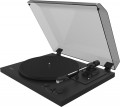Non-removable
The presence of a non-removable pickup in the design of the player.
The pickup (cartridge) is a key part for any turntable; failure of this part renders the entire device unusable. Therefore, non-removable (that is, unsuitable for replacement without disassembly in a workshop) pickups are made mainly in low-cost players, where the manufacturer tries to simplify and, accordingly, reduce the cost of construction. However, even in such models, usually, it is possible to replace the most delicate part of the pickup — the needle.
Model
Model of the pickup (cartridge) supplied with the player. The pickup is one of the most important parts of any vinyl player, the quality of the received sound largely depends on its quality. Knowing the name of the model, you can find detailed data on it and determine how satisfied you are with this particular cartridge.
Output level
The signal level at the output of the pickup supplied with the player is, in fact, the power of the signal coming from the pickup to the phono stage. This parameter is necessary, first of all, in cases where the player is planned to be connected to an external phono stage: such equipment must be designed for the corresponding power of the signal coming from the pickup.
Downforce
The force of pressing the needle on the plate, which the complete pickup (cartridge) is designed for.
This force depends on the rigidity (compliance) of the needle: the greater the clamping force, the harder the cartridge, respectively, the less pliable it is. It is also believed that less pressing force wears out the record less, but it cannot be said that "light" cartridges are definitely better — there are many other nuances. So in fact, information about the pressing force of a complete pickup is needed mainly in case of its replacement. Usually, the pressing force provided by the arm of the turntable is regulated within these limits, so the new cartridge must also be rated for the same values of downforce — otherwise there is a chance that the turntable will not be able to correctly align.
Pickup weight
The weight of the pickup (cartridge) supplied with the turntable.
The weight of the cartridge determines the characteristics of balancing the tonearm to set the optimal tracking force. However, pickups in set are usually optimally compatible with the corresponding tonearms, so there are no problems with adjusting the turntable. But when buying a replacement cartridge, you should pay attention to this parameter: it is advisable that the new cartridge does not differ too much in weight from the old one, otherwise the tonearm adjustment range may not be enough for the correct balance.
Tonearm effective length
The effective length of a tonearm in set is the distance from the attachment point (axis of rotation) to the stylus.
This indicator is important primarily for rotary tonearms: the longer the length, the lower the angular error, the smaller the discrepancy between the direction of movement of the track and the longitudinal axis of the pickup (for more details, see “Type”) and the lower the level of corresponding distortion. In addition, a longer length reduces the resonant frequency and reduces the likelihood of distortion. On the other hand, a longer tonearm turns out to be heavier, which requires certain technical tricks and can also negatively affect the purity of the sound. Therefore, a large length is not always a guarantee of high quality – you should also pay attention to weight (see below).
Phono stage
A phono corrector is a specially designed preamplifier used when working with vinyl record pickups. Initially, the sound on such records is recorded with distortion of the amplitude-frequency characteristic, namely with an increase in volume from low to high frequencies; this is due to the technical features of the recording process. Accordingly, the phono corrector not only amplifies the signal to a level sufficient for feeding to the power amplifier, but also corrects the amplitude-frequency characteristic, “pulling out” the bass and reducing the volume of the HF. And
the built-in phono corrector allows you to connect the player to the power amplifier directly, without using intermediate equipment. True, in terms of characteristics, built-in preamplifiers-correctors are inferior to external ones. Therefore, some models with this function may provide
a “bypass” mode, allowing you to pass the signal bypassing the built-in phono corrector to an external, more advanced one. And there are also
vinyl players without a phono corrector at all.
Features
—
Tempo adjustment. The presence in the player of an electronic module that allows you to change the tone of the sound being played, in other words, to make it higher or lower by a certain interval, in other words, change the playback speed. This feature is also known as a "pitch controller". It is relevant primarily for DJ "turntables", as it allows you to mix tracks recorded in different keys. Some home players also have a tempo control, but its capabilities are much more modest, and a real need for such a function rarely arises.
—
Adjustable counterweight. The ability to adjust the position of the counterweight mounted on the opposite end of the tonearm from the cartridge. This allows you to change the balance of the tonearm by adjusting the downforce (see above); the presence of an adjustable counterweight is highly desirable if you plan to use "non-native" pickups with the player.
—
Anti -skating. The presence of an anti-skating system in the design of the tonearm. The peculiarities of the work of the vinyl player are such that during playback there is an additional force that presses the needle against the inside of the groove. This results in an imbalance in the sound of the stereo channels and uneven groove wear. To compensate for this phenomenon, anti-skating is used — a system that “pulls” the tonearm in the opposite direction, towards the ou
...ter edge of the record. Anti-skating may be based on counterweights, springs, magnets, or other devices, but anyway, this function is considered highly desirable for modern turntables. However, it is not available everywhere: for example, in low-cost models, anti-skating may not be provided to reduce the cost, and in top-end devices it may be present, but not indicated in the specifications.
— Reverse playback. The reverse function allows you to play the record in reverse, playing the sound backwards. This feature is unlikely to be needed by audiophiles, but it is very much appreciated by DJs, as it expands the arsenal of available sound effects. Usually, direct drive is required for reverse (see above), although there are exceptions.
— Hitchhiking. A system that automatically stops the disc and raises the arm when the record has finished playing. Due to this, additional wear of the needle due to movement along the plate "idle" is prevented. However, in some situations (for example, when playing several records in a row), hitchhiking is inconvenient, so it can be turned off.
— Autoplay. The presence in the player of automatic playback. In such models, the user does not need to manually move the tonearm. In fact, it is enough to install the record, press the button — and the disc will start to rotate, the tonearm will lower itself to the desired position, and after the end of playback, the record will stop, the tonearm will rise (due to hitchhiking, see above) and return to its original position. Such systems make the player as convenient as possible, but they significantly affect its cost, and also (like any additional electronics) are a potential source of interference.
— Built-in acoustics. The presence in the player of its own speaker system, consisting of speakers and a power amplifier. This equipment allows you to listen to records without the use of external equipment; in fact, models with acoustics are stand-alone music centers, except that they work not on cassettes / discs / flash drives, but on vinyl discs. At the same time, the characteristics of the built-in amplifiers and loudspeakers are generally noticeably more modest than those of external ones, and additional electronics in the player's case can distort the signal. Therefore, it makes sense to purchase models with built-in acoustics if purity and high sound quality are not critical — for example, for listening to old records.
— Speed 78 rpm. The ability to operate the player at a speed of 78 revolutions per minute. To date, such records are almost never produced, but they were very popular until the 60s of the XX century. Therefore, to listen to vintage audio recordings, you will need a turntable with support for this speed. Note that 78 rpm operation may require additional equipment (such as a belt pulley or a special pickup).
— Write to media. The ability to connect an external media to the player and record the reproduced sound on it in digital form. Usually, we are talking about USB-drives (such as flash drives); accordingly, a USB Type A port is provided for their connection. However, other types of media, such as memory cards, may be supported. Recording directly to media is faster than digitizing via a computer (see "USB port (type B)" above), but the sound is recorded "as is" in this case, without the possibility of quality enhancement and noise filtering.
— Installation of the second tonearm. Possibility of installing an additional tonearm on the player, which can differ markedly from the main one both in its own features and in the characteristics of the pickup. This possibility is justified if the player is planned to be used in different modes that cannot be covered by a single pickup. For example, you can install an inexpensive pickup on the second tonearm, which is not a pity to “kill” on old worn records, or a 78 rpm cartridge for vintage recordings. Note that in some models there may be more than one additional tonearms.
— Pendulum alignment. Automatic turntable leveling system based on a pendulum (suspension). This feature is found exclusively in premium class models, designed for the highest mechanical precision. In such models, the player itself is installed on a special stand on the floor, and a massive (several tens of kilograms) pendulum is suspended from its lower part. While the pendulum hangs strictly vertically, the player's disc is in a strictly horizontal position; and due to the large mass, the suspension practically does not deviate from the vertical with small vibrations of the floor (for example, from people walking nearby). This feature is designed primarily for sophisticated audiophiles who want to get the most accurate and reliable sound.Frequency range
The range of frequencies that the player is capable of outputting when using a standard pickup.
The wider the frequency range, the more complete the sound picture will be, the less low and/or high frequencies will remain behind the scenes. However, from a practical point of view, it does not make sense to expand the range beyond the values \u200b\u200bof 16 – 22000 Hz — it is within these limits that the human ear hears the sound (and even then not everyone). In high-end audio equipment, including turntables, there are more extensive ranges; however, such characteristics are a kind of “side effect” of high-end technology that manufacturers use for advertising purposes.
In addition, we note that an extensive frequency range is not yet a guarantee of high-quality sound: the sound picture depends on many other parameters, from the amplitude-frequency response to extraneous interference.

